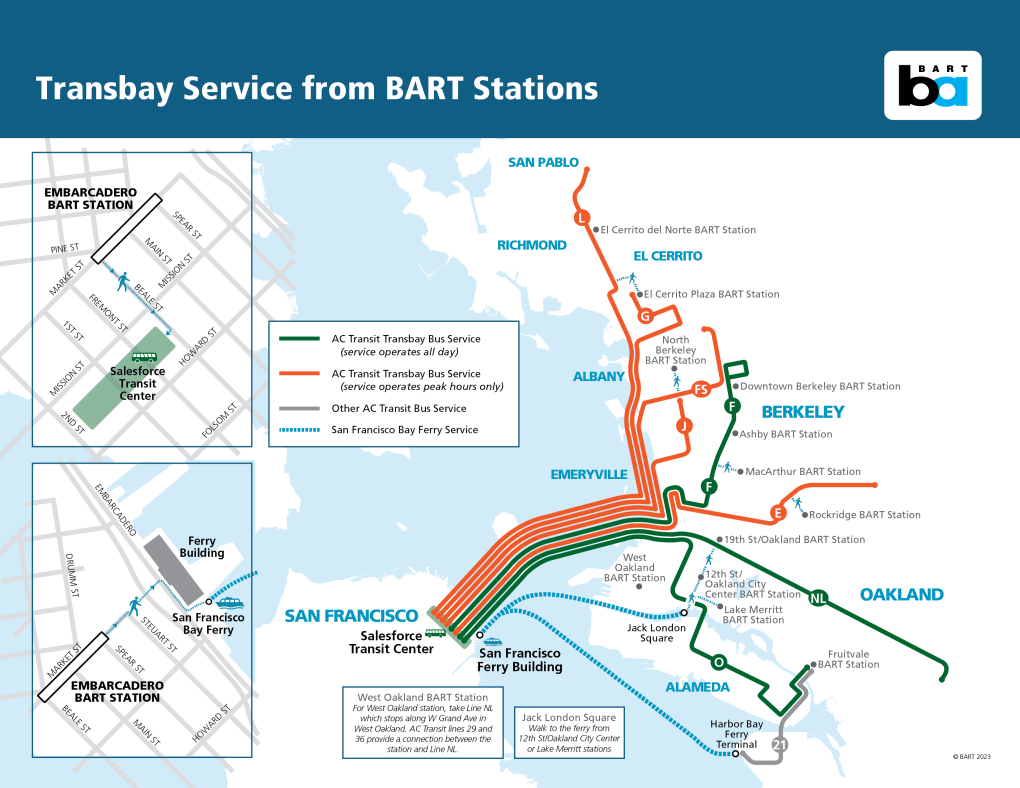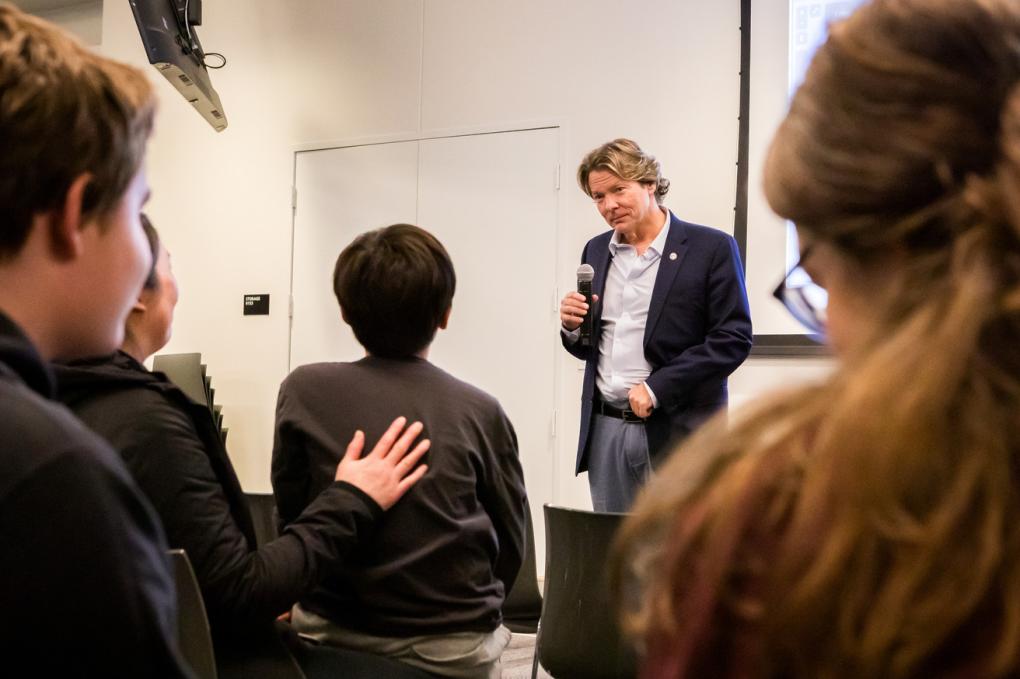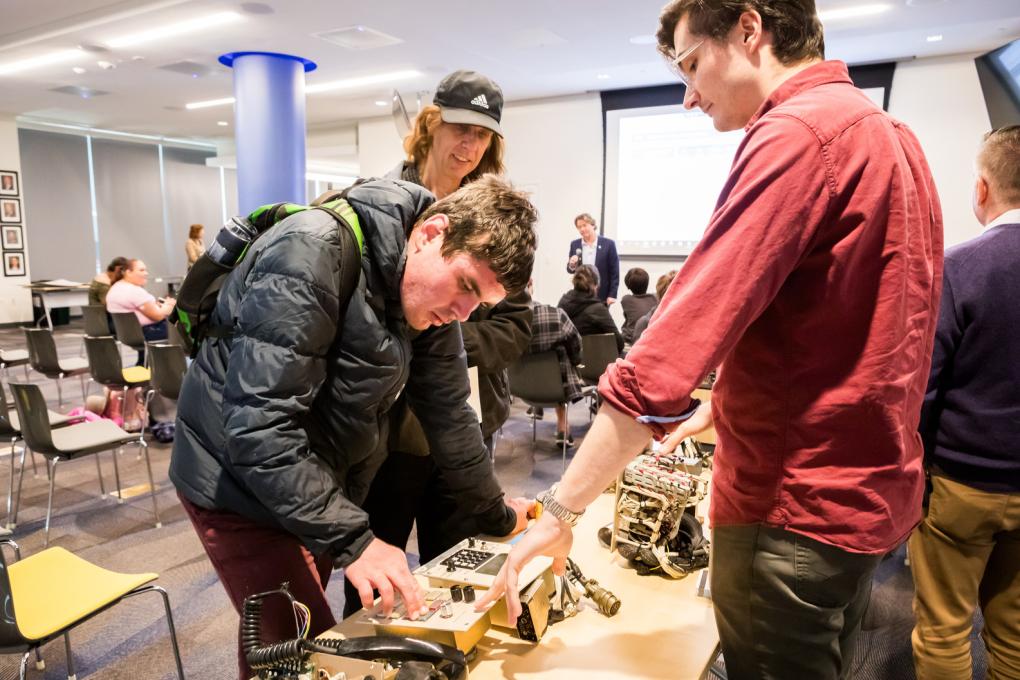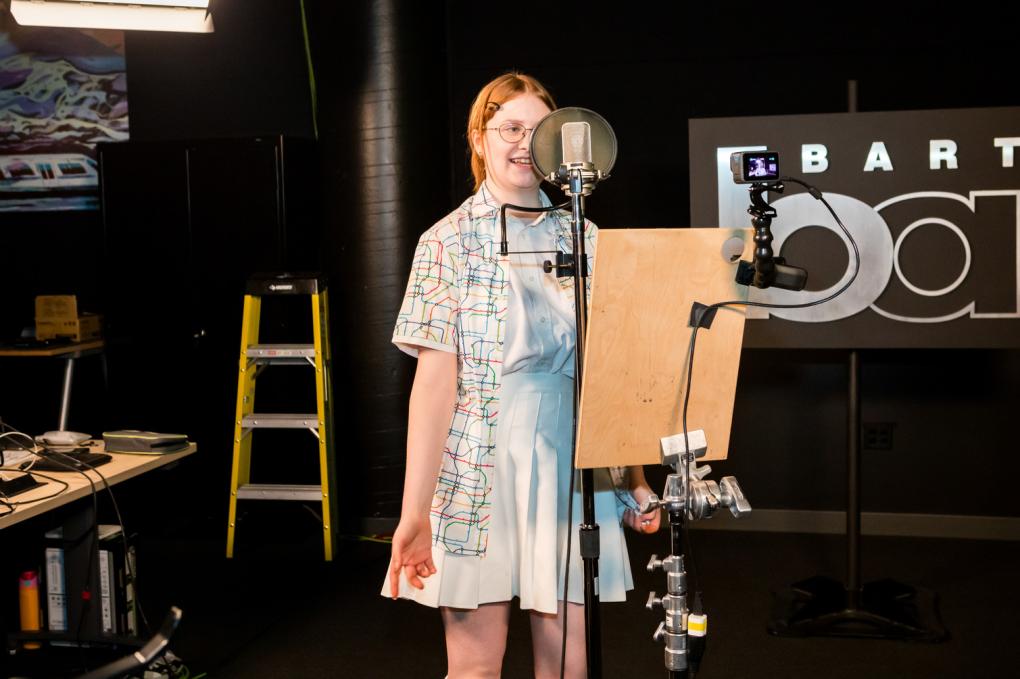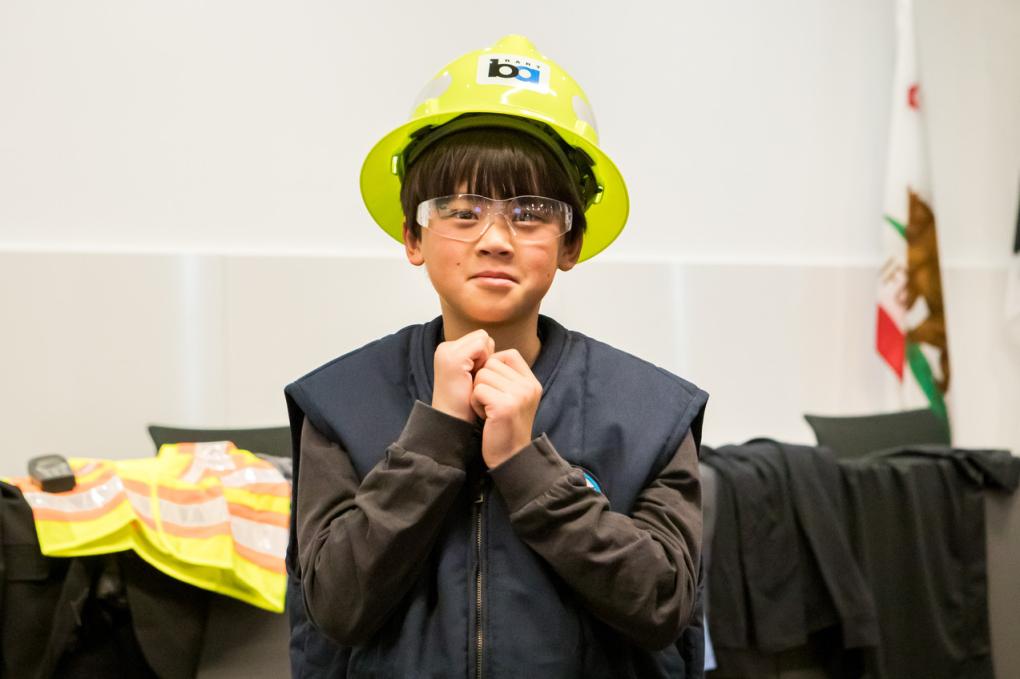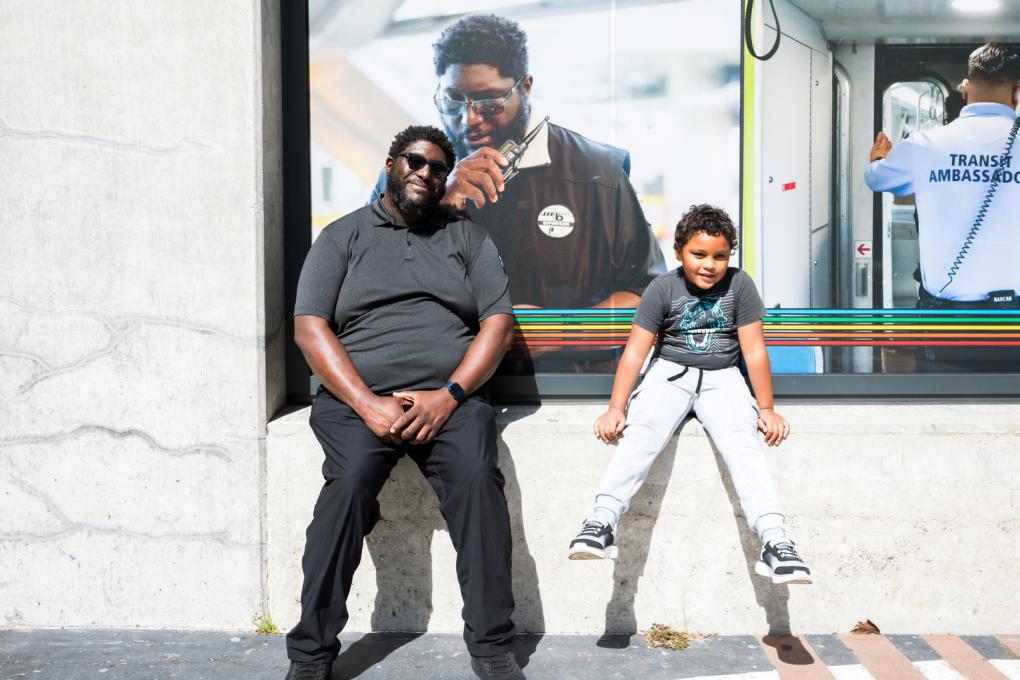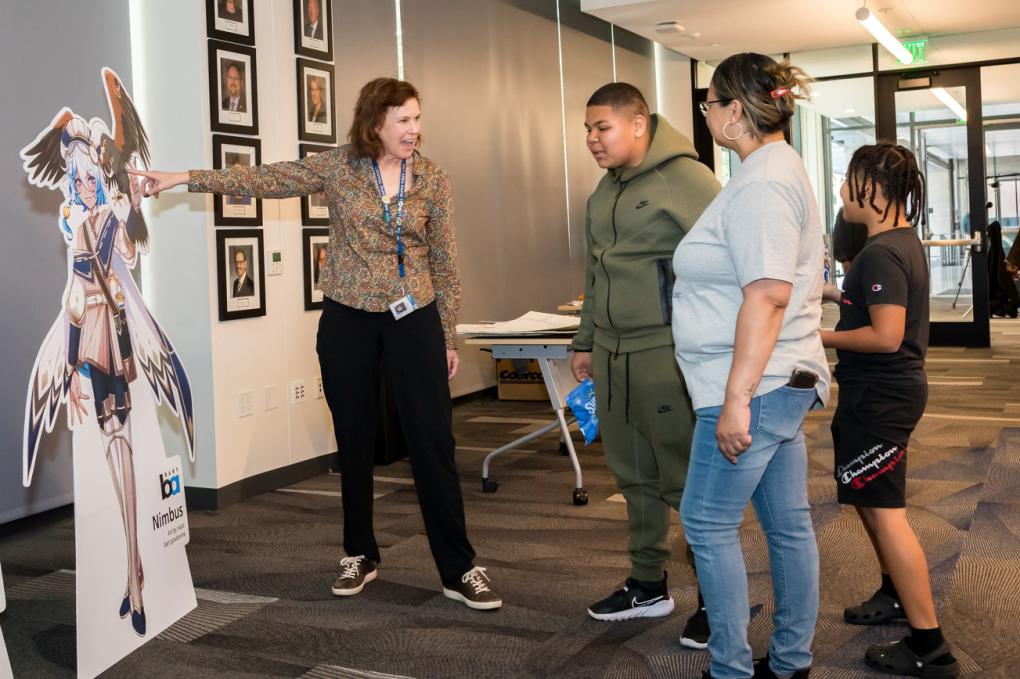Search Results
BART holiday sweaters are here! Order on Railgoods.com or purchase in-person at stations and SweaterFest 2025
The temperature is dropping and gray skies are rolling in. You know what that means – it's time to buy your 2025 BART holiday sweater! Stay cozy, rep the Bay, and support BART at the same time.
BART holiday sweaters, beanies, and just-released holiday socks are now available for purchase on Railgoods.com, as well as in person at BART’s Customer Services Center in Lake Merritt Station, at station pop-ups (see below for dates and locations), and during SweaterFest on Dec. 13.
At checkout on Railgoods, you will have the option to select shipping or pickup at the Customer Services Center. Orders will be ready for pickup at Lake Merritt and begin shipping the week of Nov. 3.
In addition to the new adult sweater and beanie, BART is selling a special sweater for youth featuring BARTy. Red and green sweaters were available only during the presale – if you missed ‘em, you missed ‘em, but you can still get a sweater in beautiful BART blue.
Planning to gift BART merch to the transit lover in your life? Railgoods.com just unveiled wrapping paper that features a Fleet of the Future D car, the BART to Antioch Diesel Multiple Unit (DMU) car, and a BART to OAK car. If you know, you know.
Sizes + Pricing
Adult Sweater – $49.99, S - 4XL
Youth Sweater - $34.99, S (6/8), M (10/12), L (14/16), XL (18/20)
Beanie – $15.99, one size
Railgoods Station Pop-Ups
Wednesday, Nov. 5, 3pm to 6pm, Downtown Berkeley Station
Wednesday, Nov. 12, 3pm to 6pm, Fremont Station
Wednesday, Dec. 3, 3pm to 6pm, Walnut Creek Station
Wednesday, Dec. 10, 3pm to 6pm, Dublin/Pleasanton Station
Wednesday, Dec. 17, 3pm to 6pm, Embarcadero Station
Preorder your holiday merchandise this summer?
If you preordered BART holiday merch over the summer, check your email for a notification that your sweater is being shipped or is ready for pickup in-person at the Customer Services Center at Lake Merritt Station (depending which option you selected at checkout).
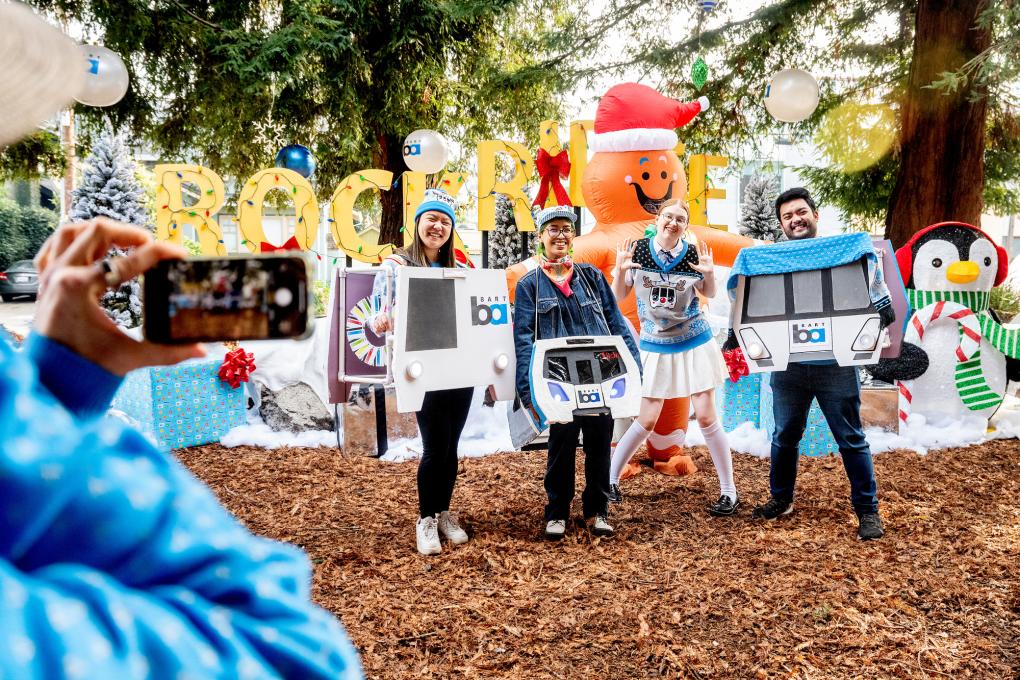
SweaterFest 2025 – Saturday, Dec. 13, Rockridge Station
SweaterFest returns!
For the third year, BART will bring holiday cheer – and lots of merch and activities – to Rockridge Station Plaza for a celebration of the season and the public transit that takes us to our favorite seasonal activities.
At SweaterFest, we encourage the Bay Area to wear a BART holiday sweater and take a group photo. Wear this year’s sweater – you'll be able to purchase one at the event – or rock a sweater from prior years. Bonus points to anyone who shows up in the first BART holiday sweater.
What to expect: Railgoods pop-up shop, live music, transit-themed crafts and other family friendly activities, snacks, photo opps, and more.
If you've been collecting stamps for your BART Stamp Passport, bring it to the event to get the new SweaterFest stamp.
Special announcements recorded by local children with autism now playing at BART stations for Autism Acceptance Month
Beginning Wednesday, April 3, you'll hear the voices of some of BART’s biggest fans playing over our PA system. For the second year in a row, BART is celebrating Autism Acceptance Month by participating in the Autism Transit Project, which invites youth on the autism spectrum to record station announcements for transportation agencies around the nation. Jonathan Trichter, who runs multiple schools for children with autism and other neurological differences, spearheads the project.
The recordings will play at 35 BART stations across the system every hour for the remainder of April. You can find the list of stations and listen to the recordings at the bottom of this announcement.
“My name is Antoine, and the reason I like BART is because it gets me to my destination without traffic,” is one example of an announcement you may hear.
Other announcements remind riders of BART rules and courtesy measures, like Bella's: "I love BART because it’s fun looking out the windows. Please remember to keep our train clean and offer your seat to someone in need. Have a fantastic day."
Some participants kept things simple and gleefully shouted out their favorite things about BART. Said Cameron: "I love BART because they run the next-gen [trains], although I do miss the old boys.”
In just two years, the Autism Transit Project has become a beloved tradition at BART. It is widely documented that some people with autism have an affinity for trains. Though it’s not entirely known why that is, experts believe the allure could be related to the repetitive and predictable natures of trains, as well as the visually and auditorily stimulating rhythms and patterns they produce as they run along the tracks and pull into stations.
“Children with autism don’t always come to language naturally, the way neurotypical children do,” said Trichter, who started the Autism Transit Project in 2022. “They grab phrases where they are most focused and may repeat them the same way other kids babble. It is not unusual for the first sentence a child with autism utters to be a regular service announcement at transit stations — something we take for granted every day. For these kids, it is the language they first use to communicate with their family and peers. That’s why this project is so very meaningful to them. I’d like to thank BART for letting these beautiful children be heard. “
To record their announcements, participants were invited to BART Headquarters, where the BART Communications team recorded their statements in a soundproof room with professional microphones and equipment. The children also did on-camera interviews after their recording sessions, which will be featured in an upcoming video.
When they weren’t recording, participants listened to presentations in the BART Boardroom from BART General Manager Bob Powers, Manager of Scheduling and Services John FitzGibbon, and Transportation Supervisor Casey Unger. They also rotated between different tables set up around the room, which were run by energetic BART staff. The stations included a table with tactile equipment from around the BART system, including a piece of rail; a dress-up station with real uniforms from a variety of BART jobs, such as train operators and station agents; a crafting table; and a capsule ball machine where participants won BART-themed prizes.
We hope you enjoy the announcements.
Announcements
The child’s name and the stations where their announcement is playing are listed below. To listen, click on the blue hyperlink.
Antoine – Fremont and Milpitas
Bella – Castro Valley and Civic Center
Cameron B. – 19th St. Oakland and Pleasant Hill
Cameron C. – Pittsburgh/Bay Point and West Oakland
Damian – Fruitvale and MacArthur
Eden – Lafayette and Walnut Creek
Emmett – 24th St. Mission and Downtown Berkeley
Isaias – Bay Fair and El Cerrito del Norte
Joseph – Berryessa and Millbrae
Lucy – Glen Park and Montgomery St.
Milo – 12th St. Oakland and SFO
Nita – Rockridge and Union City
Tougher new fare gates greet travelers at BART's SFO station in time for busy travel season

BART has equipped its state-of-the-art Next Generation Fare Gates at its showcase San Francisco International Airport Station just in time for the busy holiday travel season.
SFO Station is now the ninth in the BART system to be outfitted with the more formidable fare gates as part of BART’s highest priority capital project.
“As a transportation system, we take tremendous pride in saying our community is what runs BART," said BART General Manager Bob Powers. "Among the world’s transit agencies, BART relies the most on rider fares; they are directly responsible for funding our operations. These new fare gates will protect against fare evasion, expand access to transit-dependent riders, and reduce system downtime due to maintenance, which helps boost investment in BART’s long-term growth.”
“BART is making great progress on this initiative, which is increasing the sense of safety and security of riders while also bringing in more revenue,” said Bay Area Council President and CEO Jim Wunderman. “We applaud BART’s commitment to making the system safer and working so hard to install these new modern fare gates as quickly as possible.”
The new gates bring an exciting new look to BART. They feature clear swing barriers with a one-of-a-kind door locking mechanism to deter fare evasion. The gates include advanced 3D sensors that can detect if someone is in a wheelchair or has a bike, stroller, or luggage with them, allowing for more time before the swing barrier closes. They feature LED lighting on the swing barriers and pathway through the gate to help visually impaired riders.
“These gates at San Francisco International Airport are an important improvement for travelers and employees at the Bay Area’s premiere airport,” said SFO Airport Director Ivar C. Satero. “The sensors that allow riders with luggage additional time to get through the gates is just one of the game-changing features of the new fare gates.”
BART is moving rapidly to install Next Generation Fare Gates at more stations. Work is currently underway at Coliseum with plan to begin the installation process at Montgomery Street, Powell Street, Warm Springs, and 12th Street/Oakland City Center stations in November.
By the end of February 2025, BART will have installed new fare gates at more than half its 50 stations.
Full deployment systemwide will be completed by the end of 2025. Learn more about the project here. Riders can provide feedback about the new gates at bart.gov/comments.
Take BART to NBA All-Star Weekend events and win prizes when you ride transit
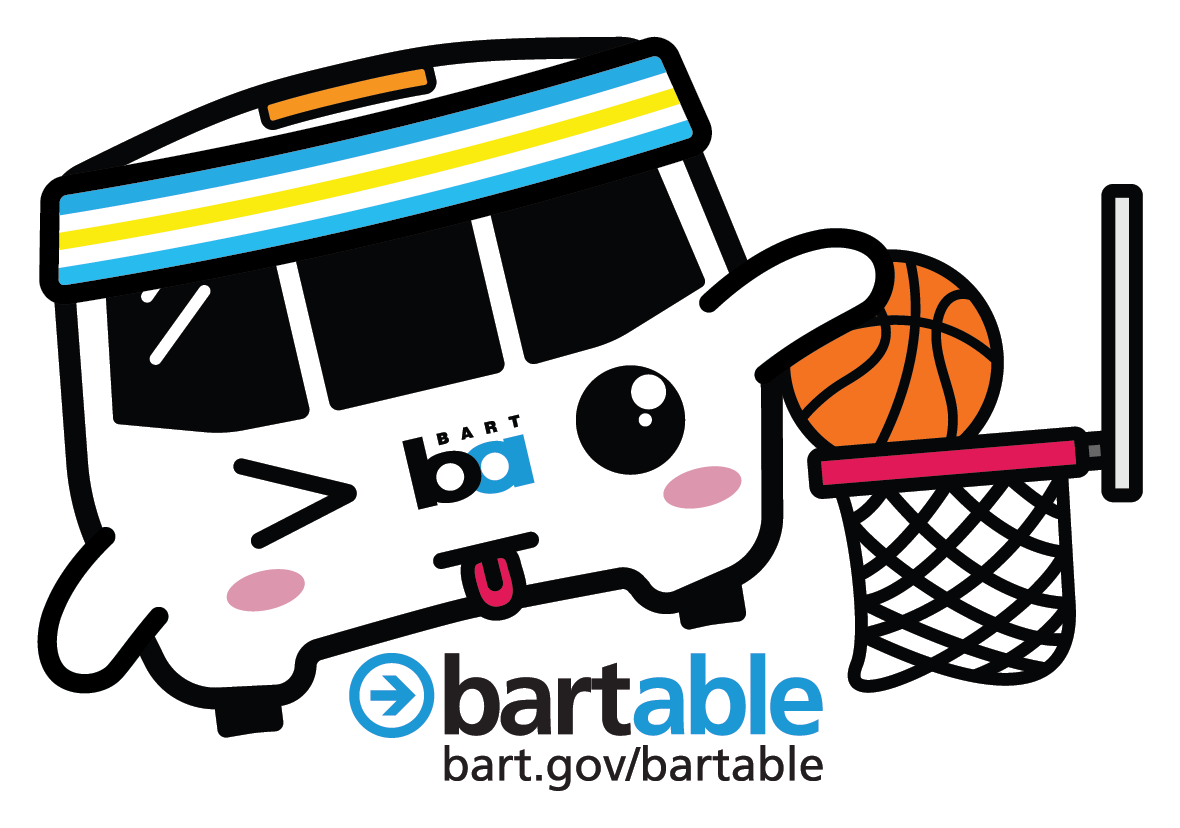
Friday, Feb. 14, marks the start of the 2025 NBA All-Star Weekend, hosted by the Golden State Warriors. BART looks forward to carrying fans to the games and events happening on both sides of the Bay. We’re also proud to partner with the NBA Players Association for the big weekend.
Follow our directions below to make your journey to games and events as smooth as Curry’s free throws. BART will adjust train lengths to accommodate ridership. Find a list of all the NBA All-Star Weekend events here.
Win free tickets and prizes
Those looking to win free tickets and other prizes can download the NBA Events app, which has partnered with BART and other Bay Area agencies to encourage riding transit around the Bay.
After creating a free NBA ID account, visit the participating stations (see below), tap the tile on the dashboard corresponding with the station, and earn your check-in via your mobile device in mixed reality. Each check-in will also count towards unlocking NBA All-Star prizes through the NBA ID All-Star Rewards Program.
Participating stations:
- 16th St./Mission Station
- Coliseum Station
- Embarcadero Station
- Lake Merritt Station
- Powell St. Station
The Grand BART Prize will be in the form of digital Railgoods.com gift cards in amounts ranging from $10 to $100.
Take transit to Chase Center
- Take BART to Powell St. Station and transfer to Muni T Third trains at Union Square Station. Signs on the platform and concourse will guide you to the right exit to catch Muni, and the special event trains will read “S Shuttle Mission Bay.” Disembark Muni at UCSF/Chase Center.
- Take BART to 16th St./Mission Station and transfer to special Muni 78X bus service. Disembark at 16th St. & Illinois St.
*Your event ticket is your Muni ticket. Ride Muni to Chase Center for FREE with your event ticket (excluding cable cars). For more information, visit the Chase Center website.
Friday, Feb. 14, 6pm: Castrol Rising Stars
Saturday, Feb. 15, 5pm: State Farm All-Star Saturday Night
Sunday, Feb. 16, 5pm: 74th NBA All-Star Game

Take transit to Oakland Arena
BART takes you directly to the Oakland Arena. Take BART to Coliseum Station and walk across the overpass and around the Coliseum to the arena. Use the arena’s North Entrance for a shorter walk.
Friday, Feb. 14, 4pm: Ruffles NBA All-Star Celebrity Game
Saturday, Feb. 15, 11am: NBA All-Star Practice presented by AT&T
Saturday, Feb. 15, 2pm: NBA HBCU Classic presented by AT&T

Take transit to Moscone Center
Take BART to Montgomery Station and walk a short distance to Moscone Center.
Friday, Feb. 14, to Sunday, Feb. 16: NBA Crossover interactive fan experience
Sunday, Feb. 16: NBA G League Next Up Game
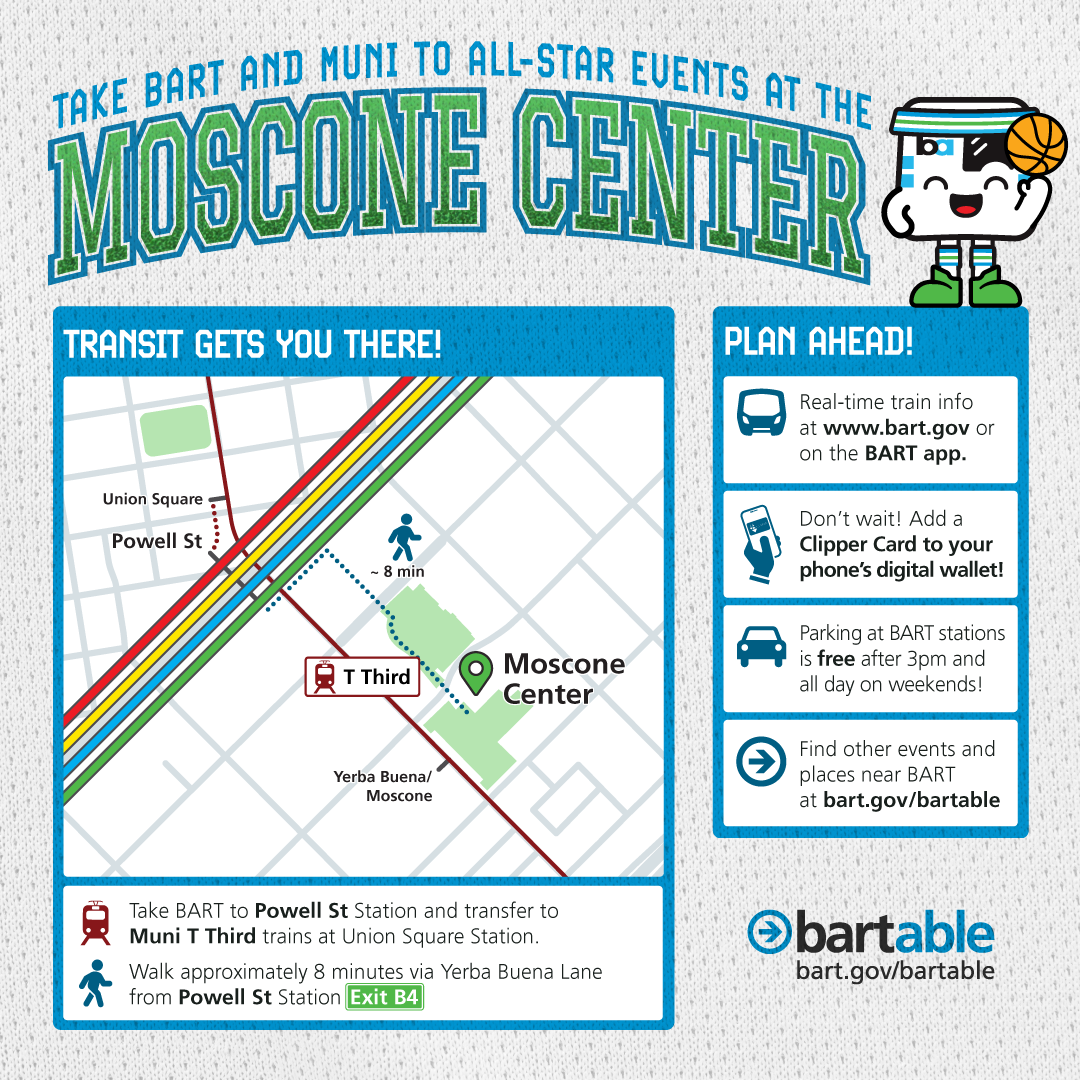
Take transit to the NBA All-Star Concert Series at Pier 48
The NBA will host a three-day concert series from Friday, Feb. 14, through Sunday, Feb. 16, at Pier 48. Headliners include Noah Kahan, The Chainsmokers, Zedd, and Flo Rida.
- Take BART to Powell St. Station and transfer to Muni T Third trains at Union Square Station. Signs on the platform and concourse will guide you to the right exit to catch Muni, and the special event trains will read “S Shuttle Mission Bay.” Disembark Muni at Mission Rock and walk to Pier 48.
- Take BART to Embarcadero Station and transfer to Muni N Judah trains on the upper level of the station. Disembark at King and 2nd streets and walk to Pier 48.
Take transit to the NBPA Brotherhood Deli at SPARK Social SF
The National Basketball Players Association (NBPA) will bring their Brotherhood Deli food truck along with activations and programming to SPARK Social SF from Friday, Feb. 14, through Sunday, Feb. 16, 11am to 6pm. It’s a short walk from SPARK Social to Chase Center.
The celebration will include player appearances, photo opps, plant-based food, immersive gaming, and hourly slam dunk shows and fan shooting contests.
- Take BART to Powell St. Station and transfer to Muni T Third trains at Union Square Station. Signs on the platform and concourse will guide you to the right exit to catch Muni. Disembark Muni at Mission Rock and walk to SPARK Social.
- Take BART to 16th St./Mission Station and transfer to the Muni 22 bus. Disembark at Mission Bay Blvd North and 3rd Street and walk to SPARK Social.
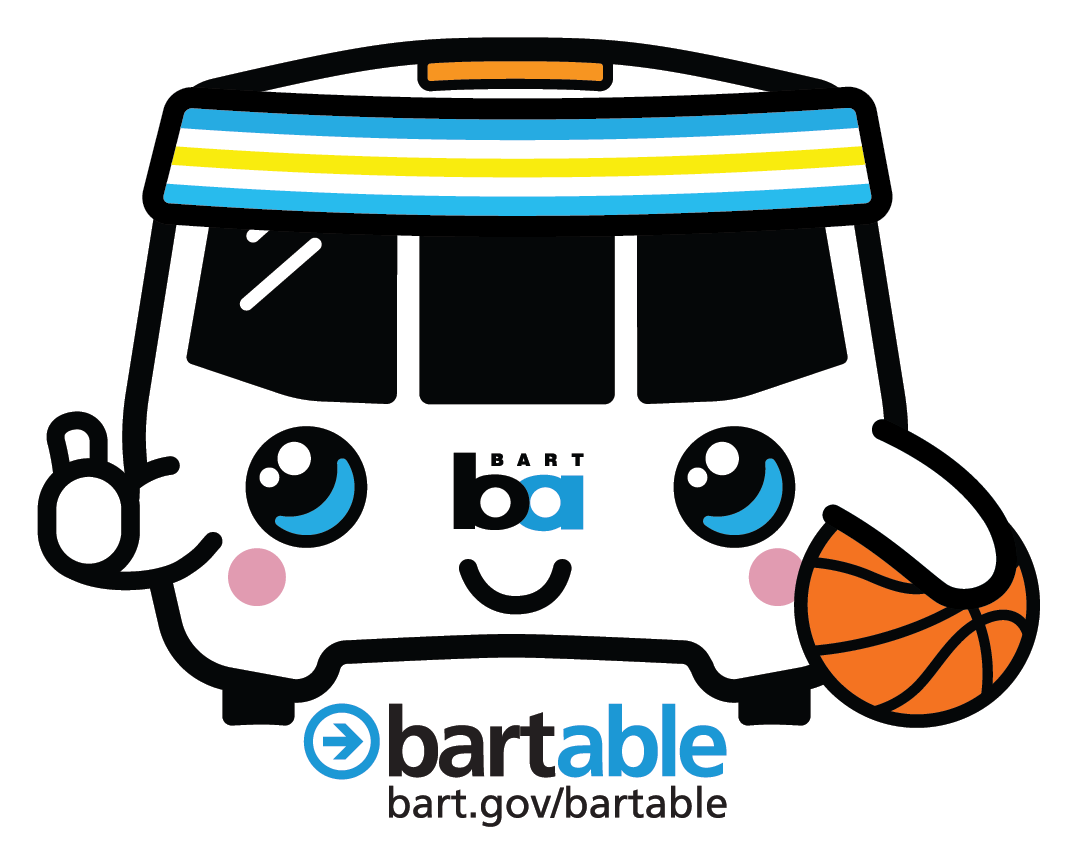
Tera Stokes-Hankins, the first woman to serve as BART’s Chief Transportation Officer, started as a Station Agent
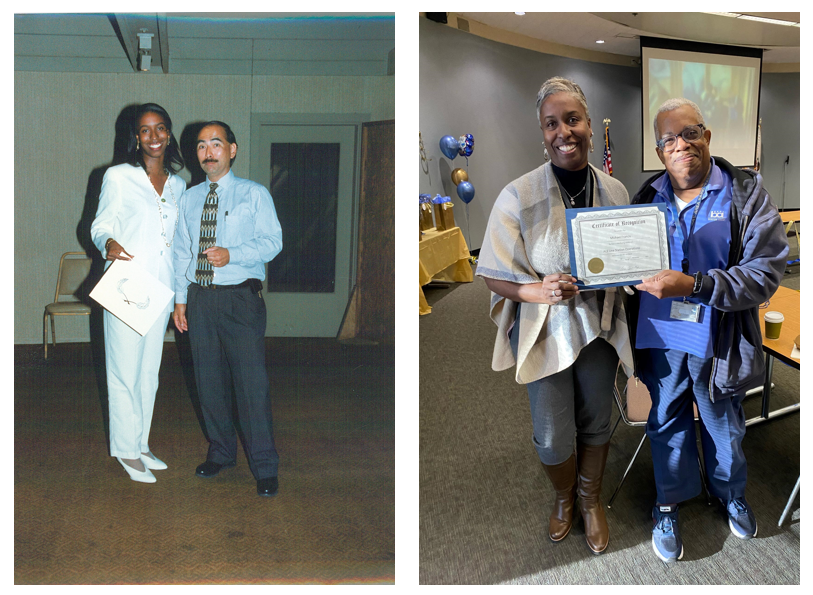
(Photos from left to right: Tera Stokes-Hankins at her Station Agent graduation in 1995; Tera handing Station Agent Michael Francis a certificate of recognition at a recent employee appreciation event.)
During Black History Month each February, BART honors the history and contributions of our Black employees, including trailblazers like Tera Stokes-Hankins, the first woman to serve as BART's Chief Transportation Officer. You'll find her "BART story" below.

Tera Stokes-Hankins joined BART in the summer of 1995 as a twentysomething near-fresh out of college. Back then, she worked part time as a Station Agent at El Cerrito Plaza Station. Today – 28 years later – she oversees not only El Cerrito Plaza, but all of BART’s stations, service and delivery of day-to-day operations, and the agency’s train operations, Station Agents, and Train Operators. Following an impressive six promotions, including one in 2023, Tera now serves as BART’s Chief Transportation Officer – one of the highest-ranking positions within the organization. She is the first woman to hold the title at the organization.
“What’s kept me here so long? The people, the relationships I’ve built, and the work is fun!” she said speaking recently on a rare break between operational meetings and field visits, during which she makes sure “we’re running the service we have promised the public.”
She credits her success to a lifelong love of people and her constant striving to be fair and honest.
“And I couldn’t have done it without my team. They are BART,” she said.
Tera's BART Trajectory |
|---|
1995 - Station Agent |
1998 - Operations Foreworker |
2001 - Operations Supervisor |
2013 - Transportation Manager |
2015 - Group Manager |
2019 - Assistant Chief Transportation Officer |
2023 - Chief Transportation Officer |
Tera grew up in Oakland and still lives there with her family. It never occurred to her to apply for a job at BART. In college, Tera majored in computer systems information and business administration. When BART came calling, she was working an entry-level position at the Federal Reserve in San Francisco and figured she’d be there awhile.
“My father was trying to get a job at BART, and he saw a listing for part-time Station Agents,” she recalled. “That led my mother to tell me I had to apply.”
Tera got the job and decided to accept the position. The rest, as they say, is history.
Every promotion since, she’s called her mom to thank her for that initial push to apply.
“I wouldn’t be here if she didn’t tell me take this job,” she said.
As for her dad? “He didn’t get the gig,” she said with a laugh.
Tera’s days are not without their challenges; being the Chief Transportation Officer is arguably one of the most stressful gigs in transit. What gets her out of bed each morning is knowing “that we are providing an absolutely essential service to the Bay Area and the people who rely on us.”
“My employees are counting on me, and my family is counting on me, too,” she said. “If BART’s not running, that means people can’t get to an interview or an appointment or class. To get up every day and make sure we’re ready to go and putting our best foot forward – that keeps me going,”
She also credits her husband with helping her stay grounded.
“It helps me in my day to day to have someone I can bounce ideas and situations off of,” she said. “He tells me when I’m right and when I’m wrong – especially when I’m wrong.”
BART is a workplace that seeks to support and elevate its employees to achieve their dreams and rise to their professional aspirations. Tera said she has been consistently uplifted by her mentors, BART’s training and educational opportunities, and the many managers who have supported her in her rise through the ranks.
“Us managers at BART have a lot to offer,” she said, reflecting. “We are just waiting for our employees to come and ask us how to grow and expand their knowledge.”
Over the past three decades, Tera has hit many of her most major life milestones while working at BART. In her first year at BART, she got married. Not long after that, she had her first child, and later, her second.
She now does for her daughter what her mom once did for her.
“I’ll see opportunities and go, ‘Baby, you should apply for this!’” The approach has paid off so far, she said.

We invite you to read BARTable's suggestions for honoring and celebrating Black History Month here and to explore One Book One BART's Black History Month Reading List, which highlights a selection of books that illuminate and educate readers about the experiences of Black Americans, especially in the Bay Area.
BART employees: Later in the month, you will receive an invitation via District Announcements for a special Black History Month event hosted by the Employee Resource Group.
Take transit to Fleet Week; BART running longer trains for the weekend (10/12 & 10/13)

San Francisco Fleet Week 2024 begins Monday, Oct. 7, and culminates on Monday, Oct. 14, and transit is the best way to get there as thousands of people flood the city for air shows and other special events.
To accomodate the predicted crowds, BART will be running longer trains that weekend: Saturday, Oct. 12, and Sunday, Oct. 13.
Here's how to reach the various air show viewing areas with BART + Muni:
- Pier 39: Take BART to Embarcadero Station and use Exit A1 to transfer to the Muni F Market streetcar or bus.
- Fort Mason, Marina Green, and Crissy Field: Take BART to Montgomery St and use Exit A1. Walk to Kearny St and board the Muni 30 Stockton bus.
- Fort Mason (option 2): Take BART to 16th St Mission and use Exit B to board the Muni 49 Van Ness bus.
Rider Tips
Parking is free at all BART stations except Milpitas and Berryessa/North San Jose (which are operated by VTA) on the weekends. Pay for parking easily on the BART app.
Before you leave home, put Clipper card on your cellphone through either Apple Pay or Google Pay. Please ensure you have sufficient funds for a round trip. Plan at the cost of your trip in advance.
Real-time departures and train alerts can be found at bart.gov/eta or on the BART app.
Discover more fun events happening this weekend on BARTable.
Fewer riders witnessing fare evasion as BART rapidly advances installation of Next Generation Fare Gates
There’s been a big decline in the number of riders who say they’ve witnessed fare evasion on BART. For our latest Quarterly Performance Report, we asked riders, “did they see anyone enter or exit the station without paying their fare today?” Only 17% of those questioned said they had, which is a drop of nearly 1/3 from the same period just a year ago when 25% of respondents said they had witnessed fare evasion.
In the last 12 months, BART has installed Next Generation Fare Gates at more than 20 stations across the system. More stations are getting new gates every month. In just the last few days installation work began at Concord, El Cerrito Plaza, Glen Park, and San Leandro stations.
“The decline in fare evasion sightings is the latest indication that Next Generation Fare Gates are transforming the rider experience,” said BART General Manager Bob Powers. “We know it’s not possible to stop 100% of fare evasion, but we are seeing that these state-of-the-art, durable gates are proving themselves to be more resistant to fare evaders and are deterring unwanted activity on BART.”
As more stations receive new gates, BART’s crime rate has dropped. Overall crime on BART was down 17% last year even as BART served 2.6 million more trips than it did in 2023.
As fewer riders are seeing fare evasion, participation in the Clipper START discount program is skyrocketing. Clipper START trips on BART for the latest quarter more than doubled to 363,238 from only 150,282 a year ago. That’s a 141% increase. Clipper START provides a 50% discount on Bay Area transit to eligible riders who have an annual household income of 200% of the federal poverty level or less.
BART has heavily promoted enrollment in Clipper START throughout the process of installing new fare gates. BART is on track to have Next Generation Fare Gates at all 50 stations by the end of this year.
The biggest BART fan in Japan flew to the Bay for a day to ride a legacy train one last time
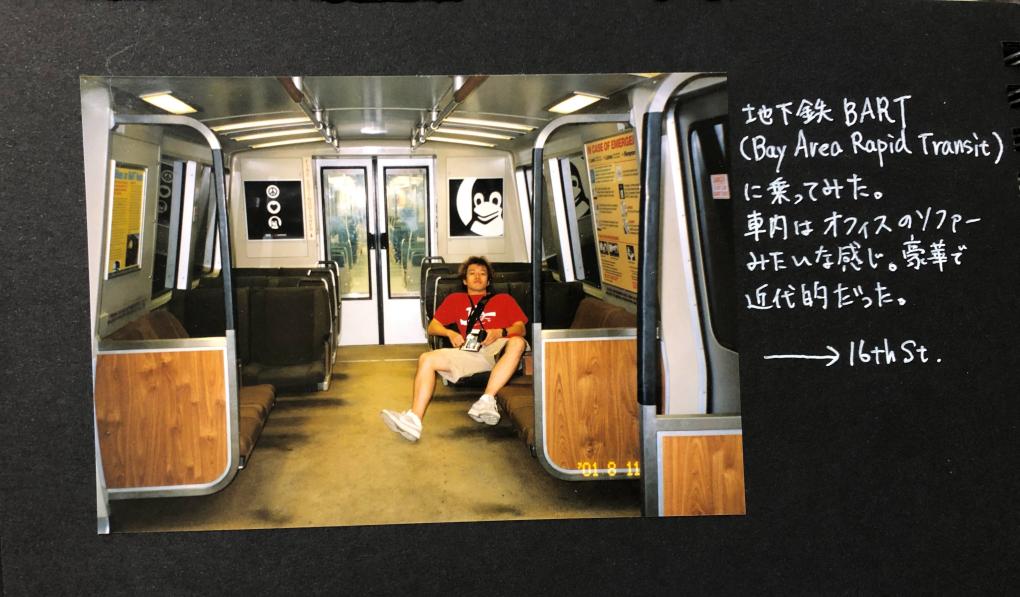
A photo of a scrapbook showing Atsushi Goto on a BART train in 2001. The text reads, "Me riding the BART subway. The vibe inside the cars reminded me of an office with sofa chairs." Photos courtesy of Atsushi Goto.
On Friday, April 19, at 3pm, Atsushi Goto’s plane touched down at San Francisco International Airport. He hastily collected his carry on, went through customs, and dashed toward the SFO BART station. A train was waiting for him on the platform.
The last time Atsushi rode BART, the trains still had yellow carpets and fabric seats. The Fleet of the Future trains were just an idea, and the legacy fleet didn’t have that adjective attached to its name yet. Actually, at the time, the legacy fleet was only a few years older than Atsushi, then a 21-year-old university student in Japan touring the U.S.
That was 2001. This past April marked 23 years since Atsushi last set foot on a BART train. And the trains that met him at SFO in April were not the ones he knew.
The 24 hours that followed his touchdown were a whirlwind of a trains, buses, cable cars, and one big party for a bunch of old trains at MacArthur Station – BART’s retirement celebration for the legacy trains. On the night of Saturday, April 20, just over a day after arriving, Atsushi was on a plane again, headed back home to Japan. Atsushi is an automobile designer, and on Monday, he had work.

Atsushi poses with the train cab cutout at the legacy retirement ceremony on Saturday, April, 20, 2024. Photo courtesy of Atsushi Goto.
“I feared this was my last chance to see these trains. I could not wait any longer,” Atsushi said, speaking on a videocall from Japan. He’d never intended for his return to the Bay Area to take so many years, but between work and his other adult responsibilities, it just happened that way.
Atsushi had heard rumblings of a BART legacy fleet retirement party and final ride from rail fans online, so every single day, he checked BART’s X account to see if the event information had been posted. He immediately started looking for plane tickets. A few weeks before, it finally appeared on his feed. Just a few days later Atsushi booked his ticket. Due to his work schedule, he could only get away for the weekend.
He has no regrets. His final ride on the legacy fleet was everything he dreamed it would be.
“It was unforgettable, a wish come true,” he said.
On his last ride, Atsushi took tons of photos, celebrated with fellow rail fans, and reflected on the 23-year-long ride that took him from his first spin on an original BART train to his final one that day. Before the train returned to the yard from Fremont Station, Atsushi said, “I touched the train to thank it for its many years of service.”
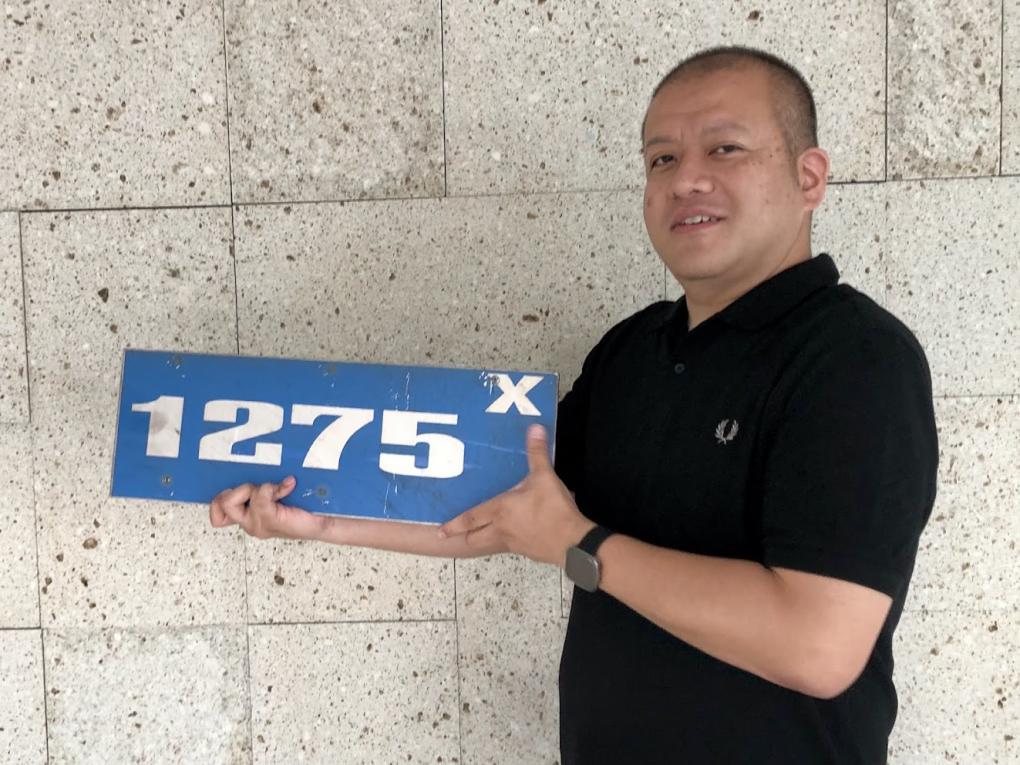
Atsushi Goto pictured with one of his legacy car number plates back home in Japan. Photo courtesy of Atsushi Goto.
BART Communications learned about Atsushi and his love of BART from Customer Services Assistant Nathan Nguyen. Nathan’s the kind of guy who’ll go out of his way to help a customer, even if that customer lives in a different time zone halfway around the world.
Before he learned about the legacy retirement event, Atsushi was desperate to get his hands on some legacy car number plates. There’s no international shipping option on Railgoods.com, where you purchase the quick-to-sellout plates, but Nathan made it happen just for him. The cost of shipping was as much as the plates themselves, but Atsushi wanted them nonetheless.
“As I got to know Atsushi communicating through email and learning the love he has for BART, I made it my mission to get these plates to him in Japan," said Nathan. "Atsushi is a very genuine guy, and the love he has for BART is overwhelming!”
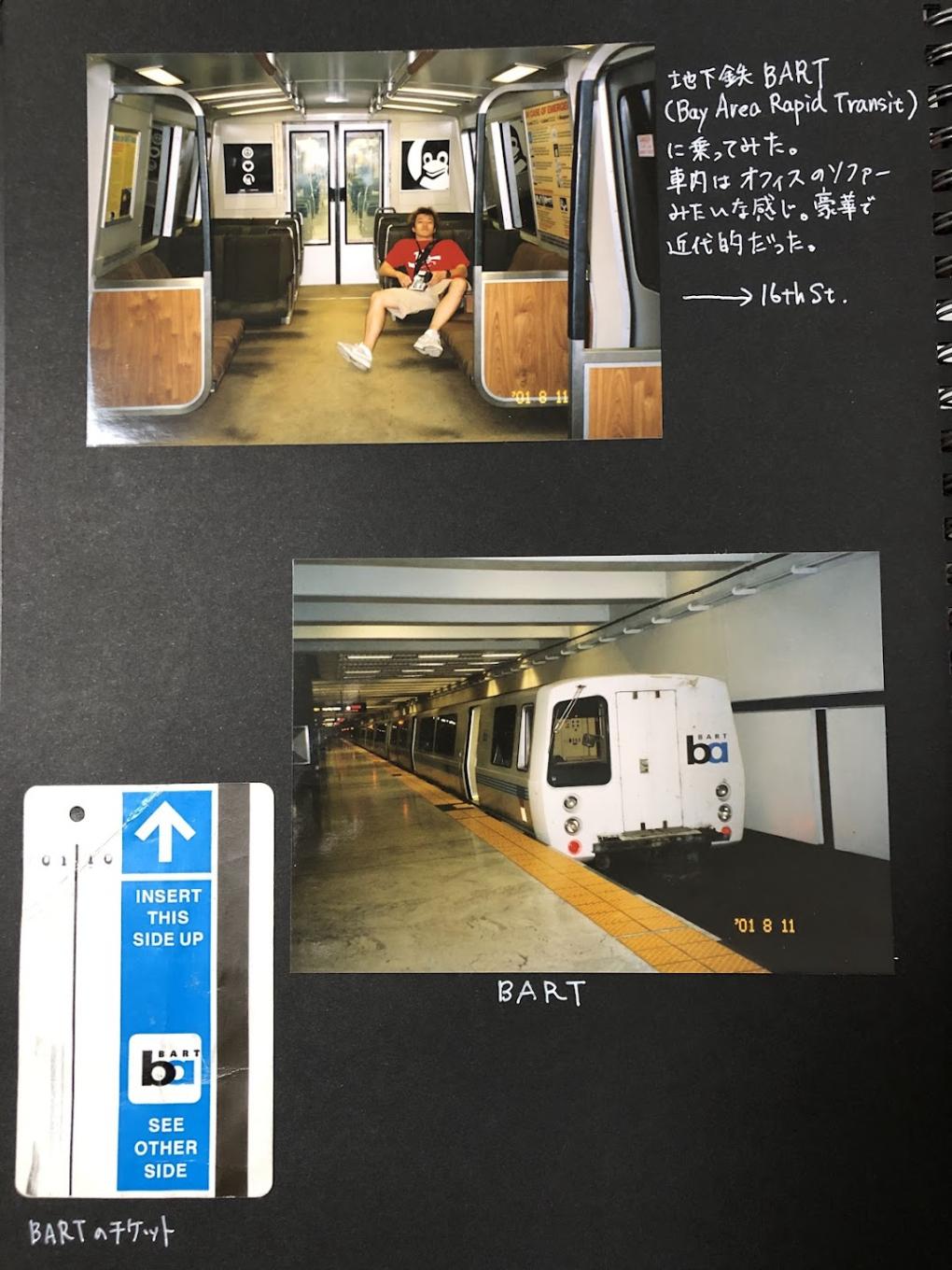
A photo of the full scrapbook page with photos Atsushi took in 2001 and the BART ticket he used. Courtesy Atsushi Goto.
Atsushi has a page in an old scrapbook commemorating his first BART ride. There’s a photo of himself at 16th St. Mission Station. He’s 21, and the ends of his hair are bleached like a true 90s kid. Below the photo, Atsushi pasted his first BART ticket. The text reads on the page reads: “I took the BART (Bay Area Rapid Transit). The interior of the train felt like an office sofa. It was luxurious and modern.”
Atsushi had wanted to visit San Francisco since he was a child. His mother used to read to him from the 1950s-era children’s book “Maybelle the Cable Car” by Virginia Lee Burton, translated into Japanese from the original English.
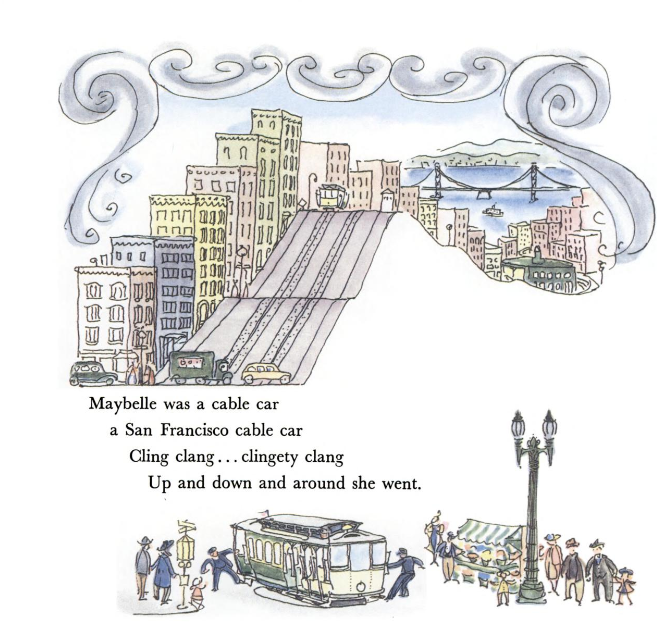
A snapshot of the opening lines of “Maybelle the Cable Car” (Copyright Houghton Mifflin).
“Maybelle was a cable car / a San Francisco cable car / Cling clang . . . clingety clang / Up and down and around she went,” the the classic story begins.
“I was really surprised by the angle of that hill,” Atsushi said.
When he finally made it to the U.S. in 2001, Atsushi felt like he was on a movie set.
“I really like America because as a child, I’d often see American movies on tv, like “Speed” and “Top Gun” with Tom Cruise,” he said. He’s also a big fan of American hard rock, including Guns N’ Roses and Aerosmith.
Atsushi on a Muni bus in 2001. The 8042 bus was retired in 2016. Photo courtesy of Atsushi Goto.
During his visit, he traveled west to east, stopping in cities along the way, including Los Angeles, Chicago, Detroit, Washington D.C., New York City, and Dallas. The Bay Area was one of his favorite places, and he spent lots of time riding its many forms of transit.
“The great thing about the Bay Area’s transportation system is that it combines modern and traditional elements and together, they function as a means of daily transportation,” he said. “For example, on the one hand there are advanced systems like BART and Muni, on the other hand, there are cable cars and the Muni F line. It’s fascinating and wonderful.”
A Tokyo Metro Series 6000 train. Photo by Atsushi Goto.
BART’s “sofa-like spacious seats and seamless exterior” made him feel as if he were riding in a vehicle from the future. The cars’ exterior design was quite unlike the trains in Japan, where most of the trains are square and boxy, Atsushi said. He noted that the BART trains influenced the design of the cab on the Tokyo Metro Series 6000 trains, which he used to ride to get to school in Tokyo. He felt a strong sense of familiarity, communion even, with the BART trains off the bat.
“The legacy train’s design is so simple and iconic a child can easily draw it. With its round headlights and large windows, the design is still fresh even 50 years after its introduction,” he added.
He also thought the stations were cool thanks to their modern architecture, red electronic display boards, and the hip BART logo and color scheme.
Atsushi eats clam chowder at a stand in San Francisco during his visit in 2001. Photo courtesy Atsushi Goto.
On his second visit to the Bay Area so many years later, Atsushi said his heart leapt when he came face to face with a BART train at SFO Station. He said his first ride on the new trains was “very comfortable,” and he appreciated the “sloping cross section and color scheme of the cars," which reminded him of the original cars. He also liked how the colors of the train “really match the beautiful Bay Area scenery.”
After dropping his bag at his hotel in downtown San Francisco, Atsushi hopped on a cable car on Market Street and rode it to Fisherman’s Wharf. After dining on some clam chowder on the waterfront, Atsushi rode back to his hotel on the F Market and Wharves Line, a heritage streetcar service that uses legacy equipment from retired fleets from San Francisco and abroad.
Scenes from the legacy train retirement event on Saturday, April 20, 2024. Photo by Atsushi Goto.
Saturday morning, he rode BART to Fruitvale Station because he got a tip that the legacy trains would be passing through the station on their way to MacArthur for the ceremony. He met another rail fan waiting for the train, too, and so they hung out and chatted while they waited.
Then, at last, he rode to MacArthur and basked in the atmosphere generated by thousands of rail fans celebrating BART and its historic trains.
A legacy train on the tracks during the legacy train retirement event on Saturday, April 20, 2024. Photo by Atsushi Goto.
On the train, he said the scene on the train was very lively and fun.
“It was a wonderful experience to sit in a spacious seat and ride while looking out at the Bay Area,” he added.
After the train pulled into its final stop – Fremont Station – Atsushi waited on the platform with dozens of other rail fans to see the trains off to the yard.
Once the train sailed away, Atsushi had one more rail system to ride. His rail fan friend at Fruitvale told him about Caltrain’s Nippon Sharyo cars, which are being retired. So, Atsushi dashed back to San Francisco, caught one of the double-decker, Japanese-made beauties, and rode it a few stops. Then, it was back on BART to SFO and a long plane ride back home.
Atsushi said he won’t let so much time pass between now and his next visit to the Bay. He admits he should have come back sooner, but when he started working after graduation, it became difficult to take long holidays.
“I would definitely like to visit again,” he said. But he’s going to wait until the Western Railway Museum opens it BART museum with its three legacy train cars.
A Timeline of Atsushi’s Whirlwind Visit to the Bay Area
9pm JST, Friday, April 19: Atsushi Goto’s plane departs Narita Airport in Tokyo.
3pm PDT, Friday, April 19: Atsushi touches down at San Francisco International Airport.
5pm PDT, Friday, April 19: Atsushi takes BART from SFO to Downtown San Francisco and walks to his hotel by Civic Center/ UN Plaza.
7pm PDT, Friday, April 19: Atsushi catches the cable car on Market Street to Fisherman’s Wharf.
9pm PDT, Friday, April 19: Atsushi rides the Muni F train back to downtown.
11am PDT, Saturday, April 20: Atsushi photographs a legacy train passing through Fruitvale Station as it heads to MacArthur for the celebration.
1pm PDT, Saturday, April 20: Atsushi attends the legacy train retirement ceremony at MacArthur Station and queues to board the last train.
2pm PDT, Saturday, April 20: Atsushi rides the last legacy train to depart MacArthur, then sees it off as it returns to the yard.
7pm PDT, Saturday, April 20: Atsushi arrives at Caltrain station and boards the Nippon Sharyo double-decker train.
9pm PDT, Saturday, April 20: Atsushi takes BART from Civic Center to SFO.
1am PDT, Sunday, April 22: Atsushi’s flight to Tokyo departs San Francisco.
5am JST, Sunday, April 22: Atsushi’s flight lands at Tokyo Haneda International Airport.
BART provides more details about computer equipment problem preventing the start of service on 9/5/25
Update 9/11/25
BART General Manager Bob Powers, Deputy General Manager Michael Jones, Assistant GM of Operations Shane Edwards, and Assistant GM for Infrastructure Delivery Sylvia Lamb provided an update (video above) of two recent service disruptions. On September 5, a computer equipment problem following overnight network upgrade work prevented the on-time start of Friday morning BART service. East Bay service was started at 9:30am and full service was available at 11:45am. On August 29, a report of smoke in the Transbay Tube impacted BART service between Oakland and San Francisco for several hours during the Friday evening commute.
Update 9/6/25
BART is providing more details about Friday's disruption in this memo to our Board of Directors. It will be discussed at Thursday's (9/11/25) Board of Directors meeting that starts at 9am during the General Manager's Report.
Update 09/05/25, 11:45am:
Regular BART service has resumed throughout the system. All stations are now open.
East Bay service was restored at 9:30am and full service was restored at 11:45am.
This service disruption occurred due to a computer equipment problem following overnight network upgrade work. The work is part of an ongoing multi-year project to replace the communications and computer systems, including hardware such as switches and routers, that support BART operations.
This is not a new project and BART has been doing this work during the hours we are not running without issues previously.
Something related to the upgrade work last night triggered a problem preventing all of our communication systems to function properly. Crews were able to isolate where the problem was coming from and they stabilized the system. We are investigating exactly what went wrong.
Update 09/05/25, 9:15am:
Limited East Bay service will start at approximately 9:30am. There is currently no service through the Transbay Tube and no service at any San Francisco stations or on the Peninsula.
Yellow Line will service will resume from Antioch to 12th Street Oakland. Blue Line service will resume from Dublin to MacArthur. Orange line service will resume from Berryessa to Richmond. BART to Antioch service is resuming now.
A computer equipment problem following network upgrade work is preventing the start of service this morning. Seek alternative means of transportation. bart.gov/alternatives provides options without BART service.
